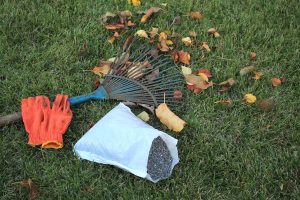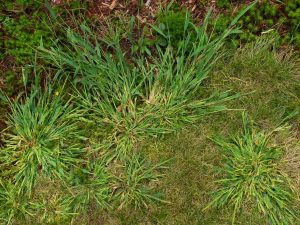The Importance of Proper Watering
One of the most common questions we get is, “how much should I be watering?” And it’s a difficult question to answer. Everyone’s lawn is going to be a little different, and the amount of rain we get can make the question tougher to answer. I want to be able to send out an update that gives you exactly how much you should water, but realistically, there’s no one answer for every single lawn. With the understanding that there’s not a One Schedule Fits All solution for your watering needs, I’ve decided to outline a lot of information about watering, so that you can see how intricate watering can be and be better prepared to react to the needs of your turf!
I know it’s long, and that’s why it’s been tough to try and condense it down. Trust me though, it’s worth it!
Turf Grass Watering Info
There are many factors that determine how much and how often you should water your lawn. The air temperature, the amount of natural rainfall, the type of turf, the soil conditions, the amount of sun, the amount of shade, and the age of the turf. These seven factors dictate how often you need to water your lawn. Water is one of the most important ingredients your lawn gets and will determine how lush and green your lawn stays. These factors listed above make it extremely difficult to advise our clients on a proper watering schedule. All of our fertilization plans will need proper watering for optimal results. If you have any questions as always please call our office and we will be happy to advise you.
Here are a few facts about turf grass and the effects of water:
- Watering too much encourages the roots of the plant to stay near the top of the soil. When the air temperatures get above 85 degrees the roots start to dry out quickly, and you won’t be able to keep enough water on your lawn, causing the grass to stress very quickly during periods of extreme heat and drought.
- Watering too much can cause fungus and other issues. If your foot sinks into the soil or spots in your turf are muddy, you should give your soil a day or two to dry up. Then, adjust the watering for that section to achieve damp soil.
- Watering too little will starve the roots of needed moisture causing the plant to go dormant. Most turf can go into this dormant (yellow mode) for 10-15 days and safely return green when proper water is applied, and air temperatures are below 85 degrees.
- When watering your lawn, make sure that your soil is damp but never sopping wet. Always give your soil time to dry up before watering again.
- Most of our lawns have clay-based soil. Clay is tough to penetrate, and water will run off when it is hot and dry. However, once water enters the soil, the heavy clay will hold the water like a bowl. In hot, dry times watering more frequently for shorter intervals is needed, while in cooler times we can water longer but less frequently.
Find your type of grass below and follow the watering plan
- Please use the following schedules to determine how to water your lawn. This schedule is by no means a fixed schedule. Time of year, weather patterns, and soil conditions will greatly impact how and when you water. Find the weather pattern on the schedule that most fits what your lawn is experiencing and follow that schedule. You can add or subtract from that as you need. Remember to dampen your soil when watering your lawn and wait for it to dry up before you water again.
- Plan to water all turf types in the early morning. Watering in the early morning gives the water time to soak into the ground but also allows the leaf blades of the turf time to dry reducing the chance of fungus. The fungus will be more prevalent when the leaf blades have water droplets sitting on them for long periods of time. When you water in the late afternoon or evenings, the leaf blades sit with water causing fungus to develop. Watering in the evenings should only be done when it is your only option!
Fescue Turf
Fescue is a cool-season turf. That means it likes cool temperatures. Once temperatures reach 85 degrees, fescue will start to decline. Water is crucial to keeping fescue from going dormant during this time. Fescue will start to turn brown when temperatures reach 85 degrees, and the turf doesn’t get proper water. When it turns brown, it is not dead! It can stay in this state for 15-30 days as long as it eventually gets some water. If your turf goes more than 40 days without rainfall or water, and temperatures are over 85 degrees, some of the fescue turf will die.
How to properly water established fescue turf:
- The recommendations below are meant to be starting points to help you find out what your lawn needs. You should check the moisture of the soil throughout the lawn daily and weekly. If the soil is too wet reduce the minutes you water for that section of the lawn. If the soil is too dry add more minutes to that section of the lawn. If that doesn’t help, then you can try adding or reducing a day of watering to help reach the proper moisture level.
- Fescue turf is established after it has been through one complete 12-month cycle. If more than 50% of your lawn was newly seeded in the past 12 months or your lawn has had new sod in the past 12 months this watering schedule may not work for your lawn. You will need to watch your lawn and water more as your lawn shows signs of stress.
Temperatures below 70 degrees: (Typically November – March)
We do not typically recommend using any irrigation at this time. The water that mother nature provides in our area will hold in the soil and give the roots of your turf the water it needs. Overwatering will only waste your water and money and encourage poor root development which will work against you when temperatures get hot.
Temperatures 70-80 degrees with normal rainfall: (April - May)
- You shouldn’t be running irrigation during this time unless your lawn is showing signs of stress. A good, hard rainfall can substitute for one watering. Your lawn should be receiving 1 inch of water per week. The soil moisture will determine your watering schedule.
- Rotating Irrigation Heads: 25 minutes per zone
- Fixed Irrigation Heads: 15 minutes per zone
- Hand Watering/Hose and Sprinkler System: 25-30 minutes per section.
Temperatures above 85 degrees with normal rainfall: (Late May – Early September)
- Your lawn should be receiving 1 inch of water per week, between rainfall and irrigation. Water your lawn about 2 times per week and never more than 3 times per week.
- Rotating Irrigations Heads: 25 minutes per zone
- Fixed Irrigations Heads: 15 minutes per zone
- Hand Watering/Hose and Sprinkler System: 25-30 minutes per section.
Fall seeding (September 15 – October 31)
The fall seeding time requires the most effort of any time during the year. Your seed will not germinate if you don’t keep the seed and soil damp and moist during the first 15-20 days. You should water as much as it takes to keep your soil damp. Use the schedule below as a starting point. Check the soil moisture throughout the lawn daily and adjust your time and duration accordingly. If you see standing water at any time stop watering until the standing water drains or evaporates and return to the schedule immediately. Don’t worry about watering during the evenings during this time. The new seed needs the water and the fungus pressure is low during this time.
Water 1 time every morning (First 15 days)
- Irrigation Heads: 12 minutes per zone
- Fixed Irrigation Heads: 5 minutes per zone
- Hand Watering/Hose and Sprinkler System: 15-20 minutes per section
Water when the soil dries out (Days 15-20)
- Water your lawn when your soil has dried out. Don’t water if it is still damp.
- Rotating Irrigation Heads: 20 minutes per zone
- Fixed Irrigation Heads: 10 minutes per zone
- Hand Watering/Hose and Sprinkler System: 25-30 minutes per section
Return to normal watering schedule (Days 20-30)
- 1 inch of water per week between rainfall and irrigation. Adjust your irrigation schedule as needed.
- Rotating Irrigation Heads: 25 minutes per zone
- Fixed Irrigation Heads: 15 minutes per zone
- Hand Watering/Hose and Sprinkler System: 25-30 minutes per section
If you have followed this schedule, you should have green, healthy, lush grass. At this time you can let Mother Nature take over for the winter. The root system will develop through the winter and early spring to give your lawn a good chance to survive the summer heat.
Bermuda/Zoysia Turf
Bermuda and zoysia are warm-season grasses that like nighttime temperatures above 60 degrees and daytime temperatures in the mid-80’s. These grasses tolerate heat much better than cool-season grasses like fescue, but they’re not completely drought tolerant. They will thrive with a consistent watering schedule. They will come out of the dormant (yellow grass) period when temperatures get to 70 degrees consistently. The grass usually greens up in April. They will actively grow from April – October. If temperatures stay above 70, the grass can stay green into early November but don’t count on that! Once the first frost hits, they will turn yellow and go into a dormant period until the spring warm up.
How to properly water established bermuda/zoysia turf:
The recommendations below are meant to be starting points to help you find out what your lawn needs. You should check the moisture of the soil throughout the lawn daily and weekly. If the soil is too wet reduce the minutes you water for that section of the lawn. If the soil is too dry add more minutes to that section of the lawn. If that doesn’t help, then you can try adding or reducing a day of watering to help reach the proper moisture level.
Bermuda and Zoysia turf grasses are considered established after they have been through one complete 12-month cycle. If more than 50% of your lawn was newly seeded in the past 12 months or your lawn has had new sod in the past 12 months this watering schedule may not work for your lawn. You will need to watch your lawn and water more as your lawn shows signs of stress.
Temperatures below 70 degrees: (Typically November – March)
We do not typically recommend using any irrigation at this time. The turf should be dormant, and no irrigation is needed.
Temperatures 70-80 degrees with normal rainfall: (April - May)
- You shouldn’t be running irrigation during this time unless your lawn is showing signs of stress. A good, hard rainfall can substitute for one watering. Your lawn should be receiving 1 inch of water per week. The soil moisture will determine your watering schedule.
- Rotating Irrigations Heads: 25 minutes per zone
- Fixed Irrigations Heads: 15 minutes per zone
- Hand Watering/Hose and Sprinkler System: 25-30 minutes per section.
Temperatures above 85 degrees with normal rainfall: (Late May – September)
- Your lawn should be receiving 1 inch of water per week, between rainfall and irrigation. Water your lawn about 2 times per week and never more than 3 times per week.
- Rotating Irrigations Heads: 25 minutes per zone
- Fixed Irrigations Heads: 15 minutes per zone
- Hand Watering/Hose and Sprinkler System: 25-30 minutes per section.
Temperatures Below 70 degrees with normal rainfall: (Late September – March)
- The bermuda and zoysia turf will not need additional watering during this time.
In Summary
Water is vital to the health and looks of your lawn. We want to help make sure you have all the information you need to succeed in having lush, beautiful turf! If you have any questions, please feel free to contact the office. We’re happy to help.
Check out this page from Lawn Care Academy for more information about deep watering mature turf.
Thank you!
Aaron Suttenfield
General Manager
RDS Lawn Care Services




